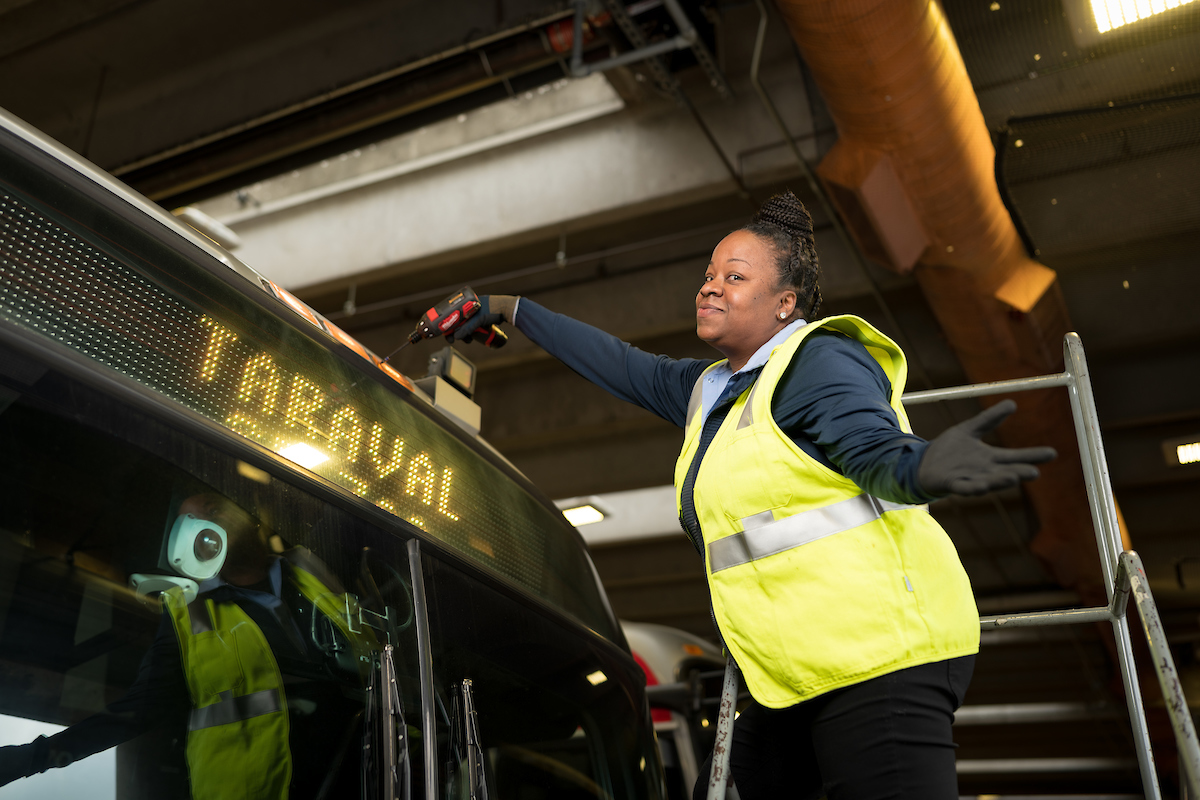
Nicole changes a clearance light to make sure riders can see the name and number of a bus.
Automotive Service Worker -- Meet Nicole Humphrey
Meet Nicole Humphrey, an automotive service worker who keeps our vehicles safe for riders. Learn how she built a career in the automotive industry and the key skills she now applies at the SFMTA. Find out what her typical workday looks like, and what she enjoys most about the job!
Coursework and jobs before current role:
Nicole’s story:
“My dad and uncles were mechanics, so I learned a lot about cars growing up,” Humphrey said.
“They taught me the responsibility of taking care of your own car. I learned how to check oil and breaks, and other things to be safe on the road.”
Humphrey was a natural. After working in customer service, she followed her passion and entered the automotive industry full-time. She started her career in fueling and servicing. Humphrey helped service cars and check them for a range of maintenance needs.
After several years, she brought her skills to the SFMTA. She recently celebrated 17 years with our agency.
Previous experience:
-
Fueling and servicing roles in the automotive industry
-
Focus: serviced cars, checked and fixed maintenance issues
Key skills required for current role:
As an automotive service worker, Humphrey plays a critical part in keeping our buses safe for the road. She runs “1k inspections.” This means she checks and works on buses that have traveled more than 1,500 miles!
Humphrey says these skills are key for the job:
-
Understand bus maintenance and repair needs
“We have to know how to do everything on top of the bus and inside it. We’re maintaining the interior and making sure the vehicle is safe to go out. That means checking the coolant is topped off, that the wipers are good and a lot more."
-
Work well as a team
“There’s never a one-on-one situation in this role. You have to work well as a team. That can mean adjusting to different personality types. Depending on the shift you have, you’ll be talking to drivers, car cleaners, mechanics and other people. So, it’s important to come in with a good attitude. You also can’t take things personally. In any automotive job, I always feel that we work together on a daily basis. So, someone might be having a bad day. You can’t make their bad day your bad day!”
-
Be ready to work
"We have to fuel and service for eight hours every shift. That might mean servicing close to 200 buses – or more. So, you have to be ready to work in this role.”
-
Identify the right person for each issue
“We have tight communication with mechanics and other people on staff. We need to be clear about what has to be fixed. We also have to identify the right person to do it. Some repairs are going to be heavy-duty or require the body shop, for example. So, it’s about knowing who should solve the issue.”
 Humphrey checks that the coolant level is where it needs to be for the bus to run properly.
Humphrey checks that the coolant level is where it needs to be for the bus to run properly.
What a typical workday looks like:
Humphrey says automotive service workers can focus on a range of work areas for our agency. Each year, there’s a signup where you can share your preference. Her work focuses largely on the 1k inspections.
-
Inspecting vehicles with 1,500 miles on them
“With a mechanic, we back buses into the pit in the morning and start on a break inspection. The mechanic is under the bus and I'm on top of it. Then, we do an overall maintenance inspection together. I let them know what needs to be fixed. Maybe mirrors need adjusting. It could also be that we have to change the clearance lights. For every bus, I also lower the wheelchair ramp to be sure it works. We make sure every bus is safe and accessible before it goes out.”
What she likes most about the job:
-
Evolving as vehicles evolve
“I think my favorite thing is that we evolve through our buses. I’ve grown through so many different cycles of buses in 17 years. We’ve had air start buses, diesel buses, hybrid buses and electric buses. We’ve even had natural gas buses! And each one is different. So, then your daily activity around them becomes different. It’s been really cool to build new skills and grow as the buses do.”
-
Keeping drivers and the public safe
“For me, it’s great to know that my daily job contributes to the safety of my coworkers as well as the public. The first person who starts the bus is the driver. We want to make sure everything works properly for them. That way, when they leave the yard, everybody who gets on is safe, too.”